
Chalcedony Gemstone: Properties, Meanings, Value & More
 Chalcedony is a microcrystalline quartz gemstone and family of stones, encompassing dozens of colored varieties. Heard of agate, onyx, or carnelian? Then you’re already familiar with some chalcedony gemstones!
Chalcedony is a microcrystalline quartz gemstone and family of stones, encompassing dozens of colored varieties. Heard of agate, onyx, or carnelian? Then you’re already familiar with some chalcedony gemstones!
But wait, is chalcedony a real gemstone? Yes, chalcedony and its varieties are all semi-precious gemstones.
If you’re wondering how to pronounce chalcedony, it’s kal-SEH-duh-nee — not the typical “ch” like “chat.”
What is the crystal chalcedony known for? In the USA, chalcedony’s blue lace agate variety is Nebraska’s official state gemstone. As a gemstone, chalcedony is known for its soft blue hues, affordable price point, and diverse variety.
Come along as we explore chalcedony’s meaning and uses, along with its varieties, symbolism, and more. Ready to dive in?

What Is Chalcedony Stone?
Most chalcedony gemstones are gray, white, or blue. Blue chalcedony gems are among the most valuable and may show subtle adularescence — an internal glow like moonstone.
What birthstone is chalcedony? Historically, chalcedony was a May birthstone, and it’s still a zodiac stone for Gemini! Today, the bloodstone variety is a March birthstone.
Celebrating a wedding anniversary soon? Chalcedony varieties have you covered! Onyx is the traditional 7th anniversary gemstone, carnelian is for the 17th, and chrysoprase is for the 18th anniversary!
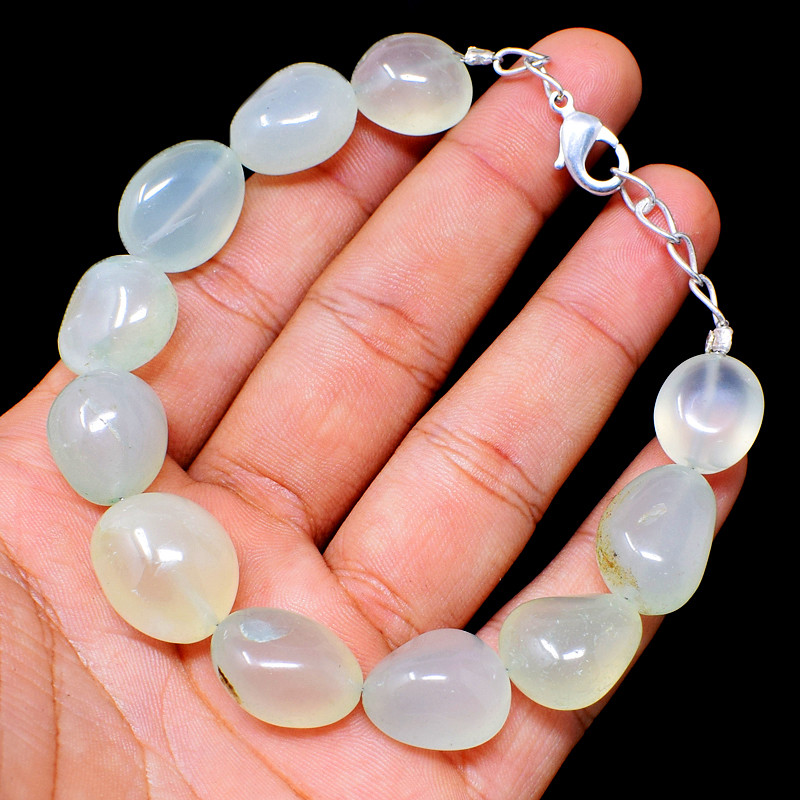
Chalcedony Specifications & Characteristics
Chalcedony minerals are microcrystalline quartz, but what does that mean? Different types of quartz stones can be either macrocrystalline (with large, visible crystals) or microcrystalline (with tiny, microscopic crystals densely compacted together). Amethyst and citrine are macrocrystalline, for instance.
The chalcedony definition doesn’t end there, though. Most chalcedony stones are combinations of microcrystalline quartz and morganite. Moganite (not morganite) is another silica stone with a different crystal structure than quartz.
Moganite content in chalcedony typically ranges from 1-20 percent. However, the mineral can also transform into quartz within chalcedony, leaving no morganite behind.
Find the rest of chalcedony’s mineral properties below:
Composition: Silicon dioxide
Mohs hardness: 6-7
Color: Varies, may be uniform, patterned, or multi-colored; Usually white, gray, gray-blue, tan, or grayish-black; Can show any color
Crystal structure: Trigonal
Luster: Rough is waxy to dull; Polished is greasy to vitreous (glass-like)
Transparency: Semi-transparent to opaque
Refractive index: 1.53-1.55
Density: 2.55-2.91
Cleavage: None
Fracture: Uneven, conchoidal, or sub-conchoidal
Streak: White
Luminescence: Sometimes fluorescent; Inert; Light green, yellow, or orange in LW-UV; Green, light yellow, or tan in SW-UV
Optical effects: Sometimes chatoyancy, iridescence (as in fire agate), adularescence
Are chalcedony stones rare? Most are abundant, but it depends on the variety, which we’ll cover next!

Types of Chalcedony
There are two main categories for chalcedony types: solid-colored and multi-colored. Chalcedony gemstones without another name attached are usually solid-colored, translucent, and most often white or blue.
Covering every single agate and jasper is beyond the scope of this guide, but you can learn more about them by clicking either! The general rule for color-banded chalcedony is that any translucent type is agate and any opaque type is jasper.
Aventurine

Aventurine is a unique chalcedony combined with feldspar. It’s typically green but comes in most colors. Fuschite causes its green hues, and higher amounts mean more opaque vibrant green aventurine.
This stone’s signature quality is aventurescence, a metallic glittering caused by tiny plates of pyrite, goethite, or hematite. Different amounts of these inclusions can create lighter and darker color zones.
Bloodstone
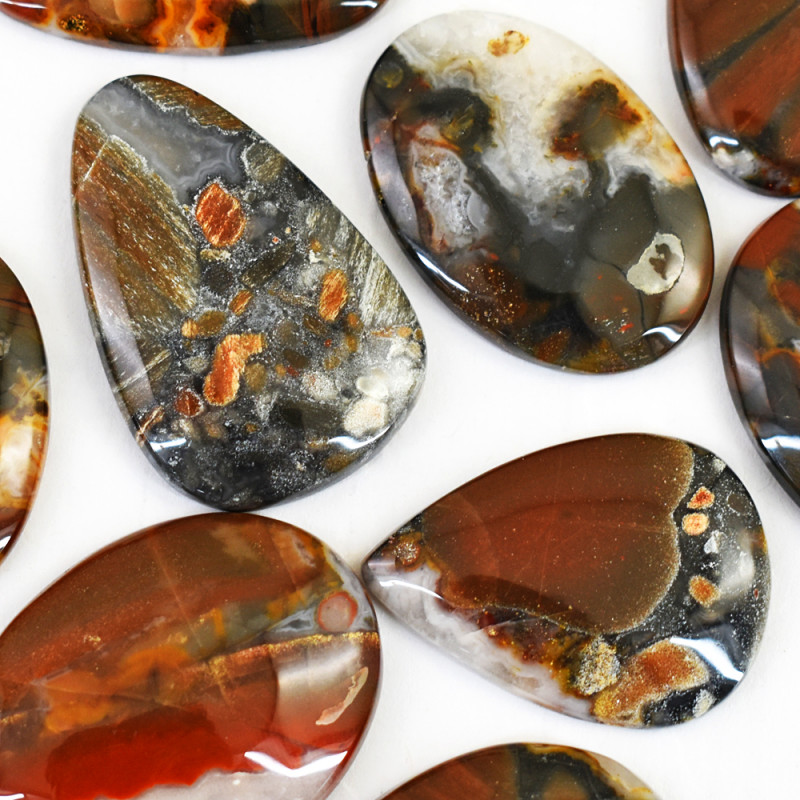
Bloodstone, or heliotrope, is an opaque, forest-green stone with blood-red speckles. If more than green and red are present, jewelers may label this stone “fancy jasper.” Another marketing term for bloodstone is “oriental jasper.”
The color saturation and patterns on bloodstone vary, from speckles to streaks or bands. The red inclusions come from hematite.
Carnelian

Carnelian is a translucent to opaque chalcedony with medium shades of red, orange, and yellow. These gems may have one, solid color or a pattern of all three hues. Reddish-orange carnelian is most valuable.
This variety is similar to sard, but sard differs from carnelian in its darker, browner coloring. Still, both chalcedony types get their color from hydrous iron oxides (yellows and browns) or iron oxides (reds).
Chrome Chalcedony
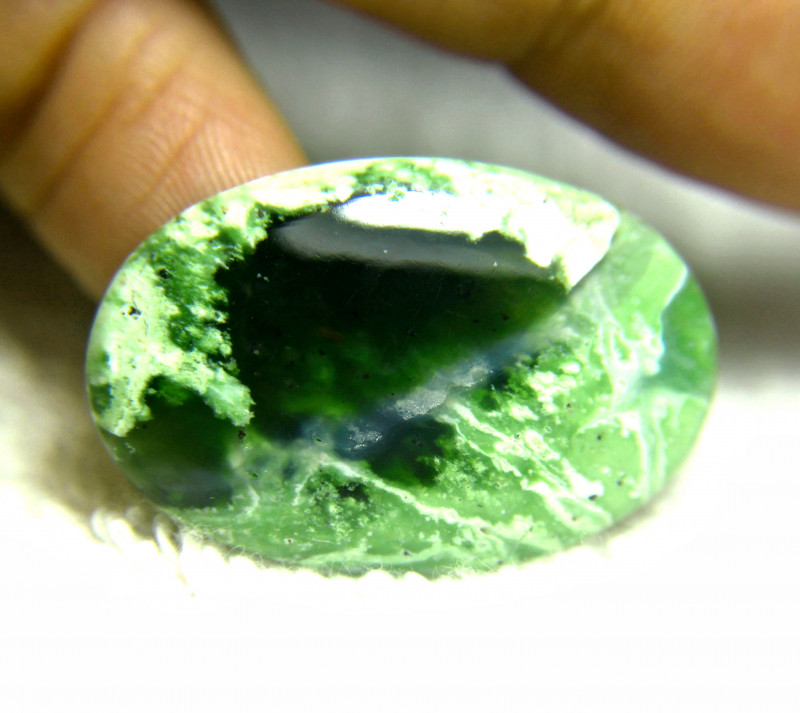
Chrome chalcedony is a sea-green to emerald-green variety colored by chromium. This largely untreated green chalcedony variety typically comes from Zimbabwe, where it’s called Mtorolite or Mtorodite.
Chrysoprase
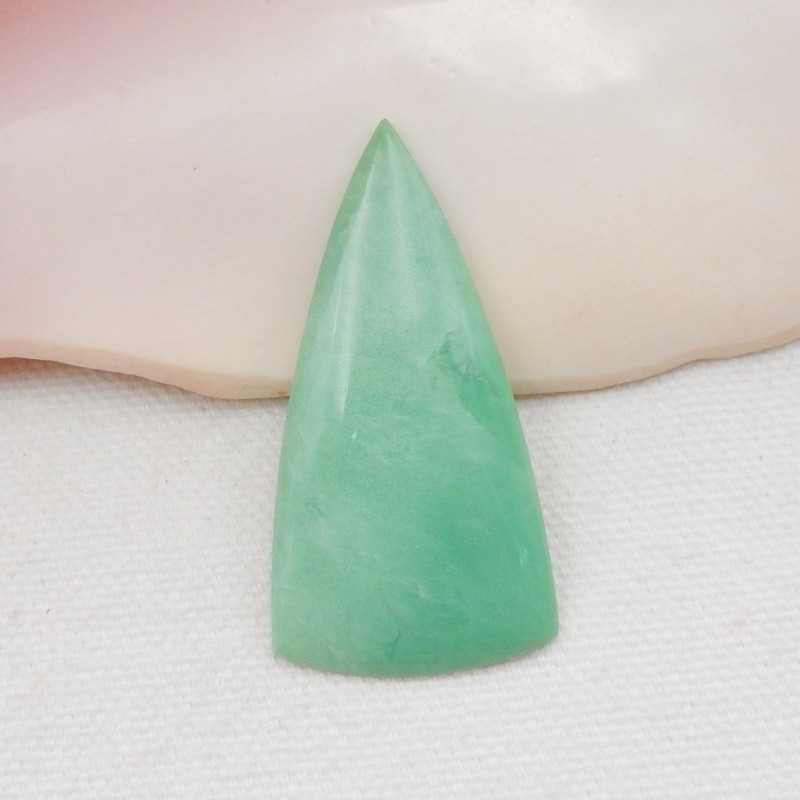
Chrysoprase, or chrysophrase, is another green variety in milky yellow-green to deep green, but most often apple-green. It’s the rarest type of chalcedony but not well-known. Unlike chrome chalcedony, green in chrysoprase comes from nickel oxide. Some jewelers use “prase” for chrysoprase gemstones with deeper but less bright green hues.
Chrysocolla Chalcedony (Gem Silica)
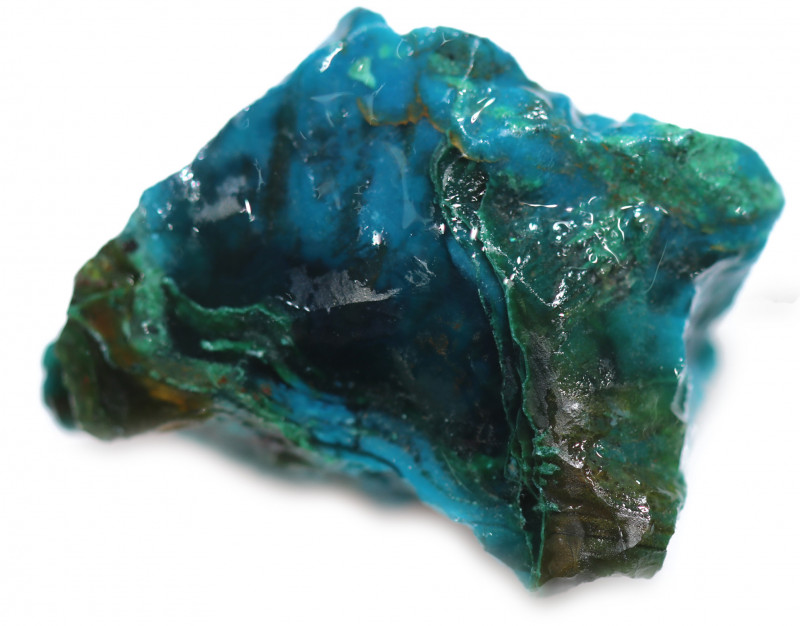
Chrysocolla chalcedony is the most valuable chalcedony variety. Sold as “gem silica,” this stone is translucent to semi-transparent and typically vibrant blue-green or blue.
Tiny inclusions of chrysocolla intergrow with chalcedony to give the stone its color. Chrysocolla chalcedony may display uneven coloring based on the number of inclusions. You may even see these crystals in geodes!
Onyx
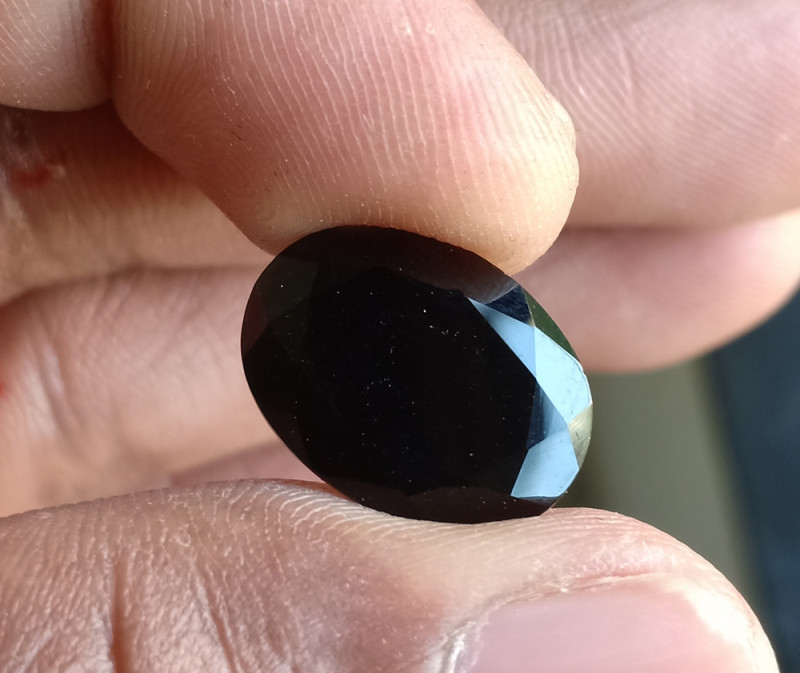
Onyx is a dark chalcedony stone with parallel bands of black, brown, white, or even purple sometimes. Gemologists disagree on whether onyx is an agate, with some claiming onyx’s flat, lined color bands distinguish it from agate’s curved bands.
You may be more familiar with black onyx, but this color rarely occurs naturally. Usually, black onyx gems are the result of sugar-acid or dyeing treatments.
Sard & Sardonyx
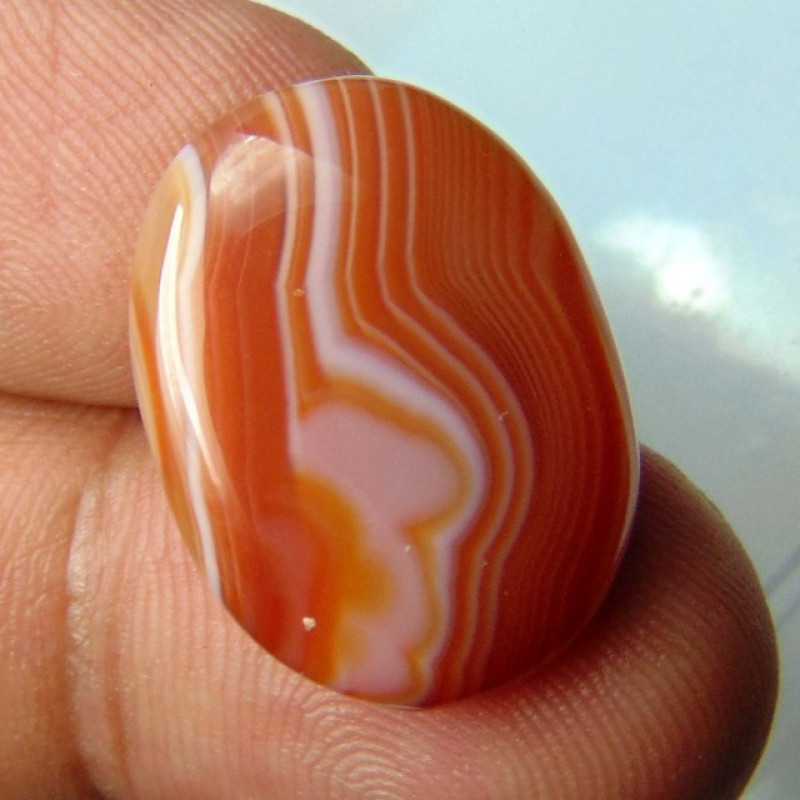
Sard is a translucent chalcedony in reddish-brown, brownish-yellow, or brown shades. When sard and onyx form together, we get an autumn-hued stone (like carnelian) with color bands called sardonyx. Sardonyx’s color bands may be white, black, or both.
Alright, let’s shift from the mineral side to explore chalcedony’s metaphysical properties!

Chalcedony Gemstone Meaning & History
First, what does chalcedony symbolize? Chalcedony represents serenity, harmony, and stability. White chalcedony is even nicknamed the “Stone of Harmony.”
Associated with the moon, chalcedony properties tie to feminine aspects, leading to another nickname: “Stone of Fertility.” The aqua chalcedony meaning is one of brotherhood (or sisterhood) and generosity.
In Greek mythology, the chalcedony crystal meaning connects to Gaia, the embodiment of Mother Earth. Ancient Romans believed the stone could improve public speaking skills. Celtic mythology links the crystal to Clota, goddess of the Clyde River. Native Americans use chalcedony as a sacred stone in tribe bonding ceremonies.

History
Chalcedony’s name comes from the Latin chalcedonius or calchedonius. Georgius Agricola, a famed German mineralogist, wrote in 1546 of the possible etymological connection to Chalcedon, an ancient seaport in present-day Kadıköy, Turkey.
Roman naturalist Pliny the Elder used “chalcedony” to describe translucent jasper in his 75-AD work Naturalis Historia.
Chalcedony’s meaning in the Bible is mentioned in Revelations (circa 95 AD) as one of the 12 Foundation Stones that partly inspired modern-day birthstones. In Judaism, the gems on the High Priest’s Breastplate included varieties jasper, chrysoprase, and sardonyx.
The earliest archeological evidence of chalcedony uses (for tools and ceremonial knives) dates back to 30,000 BC. Evidence of chalcedony seals appears frequently throughout history, as far back as 1800 BC to 1st-century AD.
Those who lived near the Silk Road trade route (active from 200 BC to 1500 AD) used chalcedony varieties like carnelian for rings, beads, and carvings.
Carnelian is especially important in Islam, as Muhammad was said to wear a carnelian chalcedony ring. He reportedly advised, “Wear the agate ring, for it will guard you from any evil.”
Shifting to more recent times, Germany started mining and carving the chalcedony agate in the 1400s. By the 1800s, Idar-Oberstein re-emerged as a major source for carved and often dyed chalcedony gems.
We know how ancient folks used it, but what is chalcedony good for now?
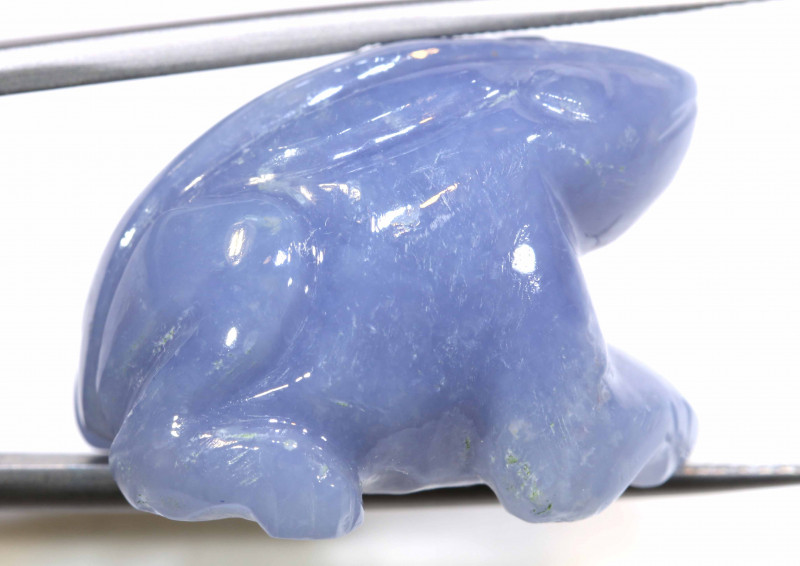
Chalcedony Healing Properties
All gemstones have spiritual significance as healing stones, often tied to their coloring. Is chalcedony a healing stone? You bet!
Like other blue gems, blue chalcedony benefits include soothing the mind and encouraging you to speak fearlessly. As a pink gemstone, pink chalcedony represents kindness, emotional healing, and tenderness.
What about the physical, emotional, and chakra healing chalcedony benefits?
Physical Healing
Chalcedony healing stones are popular for treating problems in the circulatory and digestive systems. Some purported chalcedony powers include boosting the immune system and strengthening the body while recovering from illness.
Crystal healers also use chalcedony stone for increasing stamina and re-energizing the body. Others use the gem for better mineral absorption and eyesight.
Emotional Healing
Chalcedony is said to promote emotional balance, connection, and empathy. Many crystal users say chalcedony makes them more receptive, generous, and positive.
Another emotional benefit may be emotional resilience in the face of hardship. By soothing and reassuring anxious hearts, chalcedony crystal can help dispel self-doubt and encourage you to talk about your feelings without fear.
Chakra Healing
Your chakras are energy centers associated with various symptoms. They promote overall well-being when balanced, and chakra stones can balance them. What chakra is chalcedony good for? Chalcedony is best for the throat chakra!
The throat chakra helps you understand your deepest self and confidently speak your truth. A blocked throat chakra leads to feeling weak, shy, or speechless.
You can use blue chalcedony to open this chakra, allowing you to gain better self-awareness and speak with honesty.
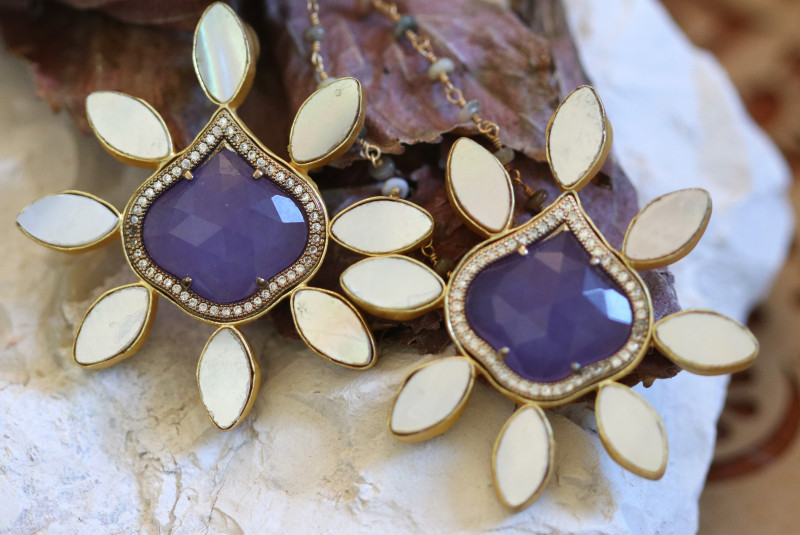
Chalcedony Gemstone Properties
Gemstone properties are what experts use to determine a stone’s quality and value. What makes chalcedony valuable? Chalcedony’s value comes down to its color, cut, clarity, and treatments.
Color
Chalcedony colors occur because of impurities like copper, iron, nickel, titanium, and chromium. The most common chalcedony color in single-colored stones is white, but pale shades of purple, gray, or blue are also common.
What is the rarest color of chalcedony? Naturally deep blue chalcedony with uniform coloring is the rarest and most valuable, though pink is also pretty rare. Chalcedony blue hues are vast, often with pink or gray undertones.
Higher saturation will mean higher prices in any natural chalcedony color.
Cut
Chalcedony comes in many forms, including faceted cuts in standard and fancy shapes. Faceted chalcedony is usually translucent to semi-transparent.
However, gem cutters typically opt for unfaceted cuts like beads or cabochons, either of which is perfect for a chalcedony necklace. Carvings are also common, both for chalcedony jewelry and decor.
Clarity
Most chalcedony stones have enough visible inclusions to look opaque or translucent and milky. Chalcedony isn’t transparent enough to have a colored gemstone clarity grade. However, semi-transparent chalcedony fetches the highest prices.
Translucent chalcedony with fewer inclusions is more valuable than a heavily included chalcedony. The only valuable inclusions in single-colored chalcedony are the parallel, dense fibers that cause chatoyancy (the “cat’s eye” effect).
Treatments
Chalcedony may sometimes be treated, especially colorless, milky specimens. Dyeing and heating are the typical treatments, both done to enhance or change coloring. Treatments are most common on pale stones, but some may be bleached before being dyed.
Heating can turn chalcedony stones with iron impurities reddish from iron oxidation. Heat treatments are usually undetectable and stable.
Jewelers often dye chalcedony blue or green to make a pale stone more vibrant or make it resemble rarer varieties like chrysoprase. Dyed blue or green chalcedony is often unnaturally bright and appears pink under a Chelsea filter.

Chalcedony Formation & Sources
Chalcedony’s formation starts with hot magma on the move. Volcanic activity pushes magma to Earth’s crust, right below Earth’s surface. Gas bubbles form as the hot magma cools and solidifies, leaving empty spaces in the eventually hardened rock.
Silica- and mineral-rich water makes its way into the spaces, where the minerals crystallize as the water evaporates. We can thank silica and oxygen for chalcedony’s basic structure and various impurities for its colors.
Color-banded chalcedony mixtures like sardonyx form when that mineral-rich water deposits multiple times, bringing new minerals. These deposits create layers of chalcedony and sard, in sardonyx’s case, that cause color-banding.
Mining Locations
Chalcedony deposits are all over the world on virtually every continent. Brazil and the USA have possibly the most diverse range of chalcedony varieties.
We’ve listed each major locality with their corresponding chalcedony type(s):
Arizona, USA - Chrysocolla chalcedony
Australia - Chrysoprase, Bloodstone, Onyx, Sardonyx
Brazil - Carnelian, Sard, Bloodstone, Chrysoprase, Aventurine, Onyx, Sardonyx, Pink chalcedony
California, USA - “Mojave” blue chalcedony, Chrysoprase, Onyx
Egypt - Carnelian
Iceland - “Aqua” chalcedony
India - Bloodstone, Carnelian, Sardonyx, Aventurine, Onyx
Indonesia - Purple chalcedony
Madagascar - Onyx, Chrysoprase, Carnelian, Bloodstone
Mexico - Chrysocolla chalcedony,
Namibia - “African blue” chalcedony
Nevada, USA - “Mt. Airy” blue chalcedony
Oregon, USA - “Holly blue” lavender-colored chalcedony, Onyx
Russia - Chrysoprase, Onyx
Turkey - Chrome chalcedony, Blue chalcedony, Chrysoprase
Uruguay - Carnelian, Sard, Onyx
Zimbabwe - Chrome chalcedony
Let’s address a crucial question: is chalcedony an expensive stone? Most often, no, but some varieties carry steeper prices than others.

Chalcedony Price & Value
Chalcedony is generally an abundant stone, so prices are usually low. Let’s look at the blue chalcedony stone price ranges first.
Faceted blue chalcedony with deep blue coloring and good translucence can reach $15 per carat. Pale blue chalcedony with milky translucence goes for $0.70-$3 per carat for faceted gems and $0.40-$3 per carat for cabochons at wholesale.
Pale blue to lavender stones from Oregon, USA — “Holly Blue” chalcedony — are among the most valuable. Holly blue chalcedony prices range from $14-$20 per ounce for high-quality rough in vibrant blues. Lower-quality rough with paler coloring is $40-$150 per pound ($2.50-$10 per ounce).
The most valuable variety, chrysocolla chalcedony, can sell for $100+ per carat for well-cut gems. These gems must also have a saturated blue color, no inclusions, and even translucence. However, chrysocolla chalcedony rough is only $0.80-$1.50 per carat.
Chrysoprase gemstones are also valuable but more affordable, fetching $2-$12 per carat for high-quality faceted gems. However, this chalcedony’s price per carat can reach $20-$40 per carat depending on the source. Chrysoprase rough at wholesale if $1.50-$2 per carat.

Chalcedony Care and Maintenance
Knowing the proper gemstone care will help keep chalcedony shining like new.
First, can chalcedony go in the sun? It depends. Most untreated varieties aren't heat- or light-sensitive. Some blue chalcedony can fade in sunlight, and irradiated chalcedony is heat-sensitive.
Can chalcedony go in water? Yes. In fact, you can enhance chrysocolla chalcedony’s color by soaking it! However, we recommend avoiding long soaks for most chalcedony.
The safest cleaning method for chalcedony is by using a soft brush, lukewarm water, and mild soap. Have a dyed chalcedony? Keep it away from ultrasonic cleaners, acetone (like nail polish remover), and household chemicals.
To prevent bumps or breaks, remove chalcedony jewelry before intense physical activities. Store it separately from other gems in a dark, fabric-lined container.
Looking to Buy Chalcedony Gemstones?
If you’re cheering for chalcedony now, we don’t blame you! With a millennium of historical uses and a plethora of varieties to choose from, chalcedony is a gemstone for every taste and style. Plus, the stone’s affordable price range can fit any budget!
Looking for a beautiful, one-of-a-kind gem with a rich history? Buy chalcedony gemstones today!
Search the Gemstone Encyclopedia
Related Auctions
Related Articles
Originally the Birthstones or gemstones were associated with a zodiac sign or the month of a individuals birth. Find out what your stone is and view the stones we have for sale
8th Feb 2021
There are dozens of quartz and chalcedony gems with various colors and patterns. Learn all about quartz properties and every type of quartz, from amethyst and agate to plasma and phantom quartz!
15th Oct 2020
Hackmanite is a pink to violet sodalite gem known for its unique color-change and luminescence. Learn why hackmanite is special, from its rare qualities to the types of hackmanite jewelry available.
28th Mar 2018
Latest Articles
Milarite is a white, green, or yellow beryllium silicate in the milarite-osumilite group. Faceted gems are rare but stunning. Discover the history, properties, prices, and benefits of milarite gems!
6th Jan 2025
Friedelite is an uncommon pink, red, or brown manganese silicate mineral best known from New Jersey and South Africa. Learn the prices, properties, uses, and history of friedelite gemstones.
23rd Dec 2024
Shortite is a rare mineral and rarer gemstone, usually found as colorless or yellow wedge-shaped crystals. Learn the value, history, and properties of shortite in this guide!
9th Dec 2024
Article Categories
How To's is where you will find helpful articles from gem Rock Auctions on how to cut gemstones, select gemstones and buy gemstones.
9 Articles




